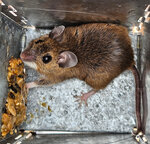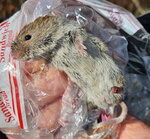 Narrowsburg
NarrowsburgLight Rain Fog/Mist, 43°
Wind: 8.1 mph
 Narrowsburg
NarrowsburgWhen we think of mice in the Upper Delaware region, we usually think of encounters with mice in our homes. We don’t usually see them, but rather, we see signs of their passing (droppings, …
Stay informed about your community and support local independent journalism.
Subscribe to The River Reporter today. click here
This item is available in full to subscribers.
Please log in to continue |


When we think of mice in the Upper Delaware region, we usually think of encounters with mice in our homes. We don’t usually see them, but rather, we see signs of their passing (droppings, nests, gnawed-on items, etc.). Mice are small, nocturnal and very secretive. These traits make it somewhat difficult to actually see a mouse in the house (or the wild).
The three most prevalent species of mice that may find their way into a home are the house mouse, the deer mouse and the white-footed mouse.
The state of PA has 11 different species of rats, mice and voles. Two of those species—the Norway rat and the house mouse—were inadvertently introduced when the settlers first arrived from Europe.
Mice and voles are very prolific breeders; some species can produce up to nine litters per year. In terms of animals (or biomass) per acre, these small rodents far outweigh the many different predators that feed on mice and voles. Predators include hawks, snakes, raccoons, coyotes, foxes and even bears if they catch one while flipping rocks for grubs.
Mice and voles live in varied habitats in the wild, in tunnels, under leaves or in rocky crevices. Some may be seen on open ground They are active at night and feed on seeds, nuts or insect larvae. Some will even feed on other small mammals. Most species hoard food for later use and to feed on during the winter.
Mice and voles are good climbers; they will climb a bush or tree to feed on berries or climb up the side of a house to gain entrance through a roof vent and get into the attic.
If you have mice in the house, there are various traps that can be used (lethal and non-lethal) to catch them, but keep in mind that they gained entry somewhere. The trapped mouse might be replaced by more mice that will use the same entry point. A professional could help here.
Please don’t use poison, as some mice make it outdoors after ingesting the poison and then are predated upon by hawks, owls or a pet cat.
Comments
No comments on this item Please log in to comment by clicking here